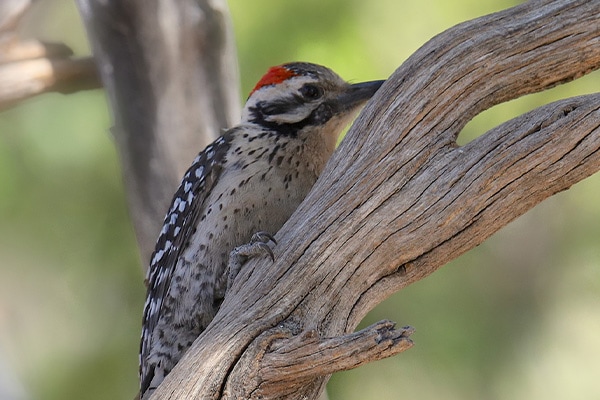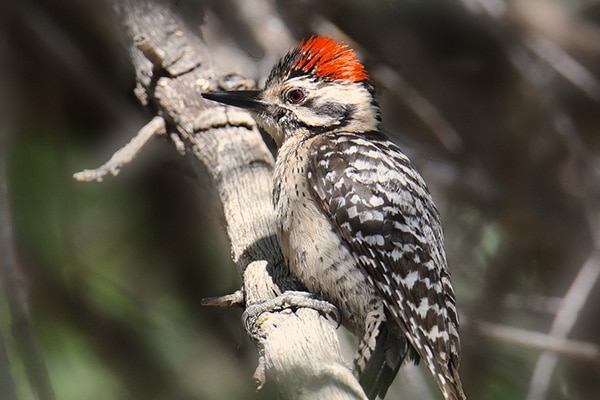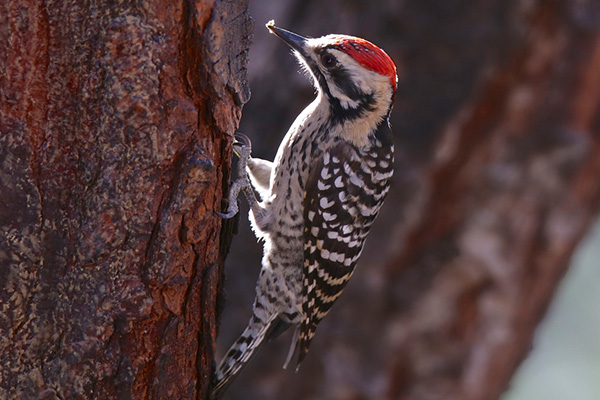Contents [show]
Ladder-backed Woodpeckers are small-sized woodpeckers commonly found in deserts and thorn forests. These areas are almost treeless, making it such a wonder how these small birds live in this kind of environment.
In this article, we will learn more about these Ladder-backed Woodpeckers. We’ll discuss:
- How to identify them
- Where you’ll find them
- What they eat
- How they nest
- Their behaviors
- How to attract them
- Their conservation status
- Interesting facts
So if you want to learn more about these birds, read on as we go through all bird facts…

Ladder-backed woodpecker facts
- Common Name: Ladder-backed Woodpecker
- Scientific Name: Dryobates scalaris
- Scientific Family: Picidae
- Life Span: 4.5 years
- Size: 6.3 to 7.1 inches
- Wingspan: 13 inches
- Weight: 0.4 to 1.7 oz
- Conservation status: Least Concern (LC)
Ladder-backed woodpecker: how-to identify
As mentioned earlier, Ladder-backed Woodpeckers are small-sized woodpeckers. With a length of 6.3 to 7.1 inches, weight of around 0.7 to 1.7 ounces, and a wingspan of 13 inches, these birds are only a size bigger than sparrows and lower than robins.
These birds are known for their black and white ladder-patterned back, hence where their name came from. You’ll also notice that they have white chests with black dots, and their white faces are lined from their bills to their eyes with black color.
Differences Between Male & Female
Male and female Ladder-backed Woodpeckers look very similar except for one distinct detail on their heads. Male birds have a red cap with white dots on one edge, while females have black caps.
Differences In Summer Plumage vs Winter Plumage
Ladder-backed Woodpeckers, like most woodpeckers, look the same all year round.
Where You’ll See Ladder-backed Woodpeckers
Ladder-backed Woodpeckers have a wide range in North America. They are primarily found in the southwestern part of the United States, going south to Mexico and British Honduras.
Unlike most birds, Ladder-backed Woodpeckers seem to adapt well in treeless areas like deserts, desert scrubs, and thorn forests with elevations of up to about 7,600 feet.
Southern California populations nest in areas with agave or Joshua trees, while those in Arizona choose various nest sites, including mesquite, acacia, hackberry, and even walkingstick cactus.
Ladder-backed woodpecker bird migration
Ladder-backed Woodpeckers are resident or non-migratory birds. This means that they stay within their range no matter what the season. So, if you’re attracting these birds during the summer season, you should expect to see them even in the winter season.
Ladder-backed woodpecker diet
The Ladder-backed Woodpecker’s diet is mainly composed of insects. This includes wood-boring beetles, leafworms, caterpillars, ants, true bugs, and some insect larvae. When needed, they also eat berries and fruits, including cactus fruit.
These birds forage food by picking, probing, or tapping with their bills, just like with many woodpeckers. However, they rarely dig into wood or even feed on the ground.

Ladder-backed woodpecker nesting
- Clutch Size: 2-7 eggs
- # of Broods: 1 brood
- Incubation Period: 13 days
- Nestling Period: unknown
- Egg Description: White and unmarked
Ladder-backed Woodpeckers pairs start forming around late January to March, and these pairs tend to stay together for a year or more.
These birds often choose larger trees as their nest sites, including Joshua tree, Willow tree, cottonwood, walnut, oak, mesquite, and agave. Male birds are the ones who do the excavating, and cavities are often formed in heights of 2-30 feet above the ground.
Nest cavities of Ladder-backed Woodpeckers often have a depth of 7-14 inches, bottom width of 3.25 inches across, and an opening around 1.25 to 1.6 inches in diameter. These birds don’t build nests inside the cavity, but cavities may contain some feathers.
Ladder-backed woodpecker behavior
Ladder-backed Woodpeckers are acrobatic birds that can twist, turn, hang upside down, and even balance on their wings when searching for food. Their flight is described as swift and undulating, often moving by hopping, walking, or climbing.
These birds are not known to be aggressive, but rivalries between males can form during the courting season. Sometimes, there are even conflicts with their close relatives, the Nuttall’s Woodpecker.
Their fighting stance is often seen as pointing with their bills, turning and swinging their heads, spreading their wings, and opening their wings for a few seconds while mid-air.
How-to attract ladder-backed woodpeckers
Like many other birds, attracting Ladder-backed Woodpeckers requires giving these birds what they need – food, water, and shelter.
Because this bird’s diet is mainly composed of insects, having an insect-friendly yard would help. At the same time, they’d also love it if you offer some mealworms at feeding stations. Other types of food you can provide are peanut butter and black oil sunflower seeds.
As these birds don’t migrate, finding food can be challenging in winter. This means that hanging a suet feeder in your backyard would be an excellent way to entice these birds. You can also plant fruits and berries to provide these birds with more energy.
Don’t forget water. This is essential to birds, especially in the winter season. On top of that, if it’s possible to keep dead trees standing, do it. Just make sure that it’s safe to do so. If it’s not, then planting trees that Ladder-backed Woodpeckers love would be a good idea, too.
Ladder-backed woodpecker threats
Ladder-backed Woodpeckers are species of low concern. It is found that their populations have remained stable since 1966, with a global breeding population of 5.9 million.
These birds don’t have any known predators.
Ladder-backed woodpecker fun & interesting facts
- Ladder-backed woodpeckers were first described to science by Johann George Wagler.
- These birds occasionally hybridize with their closest living relative, Nuttall’s Woodpecker.
- They can also be called the Cactus Woodpecker.
- The oldest recorded Ladder-backed woodpecker lived for 4 years and 6 months old.
- Williamson’s Sapsucker
- Yellow-bellied Sapsucker
- Red-naped Sapsucker
- Red-breasted Sapsucker
- Lewis’s Woodpecker
- Acron Woodpecker
- Gila Woodpecker
- Golden-fronted Woodpecker
- Red-bellied Woodpecker
- American Three-toed Woodpecker
- Black-beaded Woodpecker
- Downy Woodpecker
- Nuttall’s Woodpecker
- Red-headed Woodpecker
- Red-cockaded Woodpecker
- Hairy Woodpecker
- White-headed Woodpecker
- Arizona Woodpecker
- Ivory-billed Woodpecker
- Pileated Woodpecker
- Northern Flicker
- Gilded Flicker

